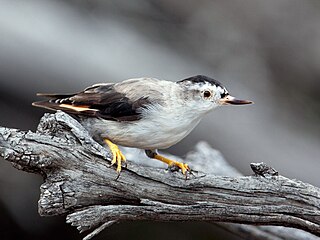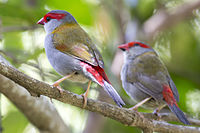
Estrildidae, or estrildid finches, is a family of small seed-eating passerine birds of the Old World tropics and Australasia. They comprise species commonly known as munias, mannikins, firefinches, parrotfinches and waxbills. Despite the word "finch" being included in the common names of some species, they are not closely related to birds with this name in other families, such as the Fringillidae, Emberizidae or Passerellidae.

The white-browed woodswallow is a medium-sized (~19 cm) passerine bird endemic to Australia. The white-browed woodswallow has very distinctive plumage consisting of white brow over a black head with the upper body being a deep blue-grey and with a chestnut under body. The females are paler then the males. The white-browed woodswallow has a bifurcated (divided) tongue like most woodswallows.

The striated pardalote is the least colourful and most common of the four pardalote species. Other common names include pickwick, wittachew and chip-chip. It is a very small, short-tailed bird that is more often heard than seen, foraging noisily for lerps and other small creatures in the treetops.

The bronze mannikin or bronze munia is a small passerine bird of the Afrotropics. This very social estrildid finch is an uncommon to locally abundant bird in much of Africa south of the Sahara Desert, where it is resident, nomadic or irruptive in mesic savanna or forest margin habitats. It has an estimated global extent of occurrence of 8,100,000 km2. It is the smallest and most widespread of four munia species on the African mainland, the other being black-and-white, red-backed and magpie mannikin. It co-occurs with the Madagascar mannikin on the Comoro Islands, and was introduced to Puerto Rico. Especially in the West Africa, it is considered a pest in grain and rice fields. It is locally trapped for the pet bird trade.

The scaly-breasted munia or spotted munia, known in the pet trade as nutmeg mannikin or spice finch, is a sparrow-sized estrildid finch native to tropical Asia. A species of the genus Lonchura, it was formally described and named by Carl Linnaeus in 1758. Its name is based on the distinct scale-like feather markings on the breast and belly. The adult is brown above and has a dark conical bill. The species has 11 subspecies across its range, which differ slightly in size and color.

The crimson rosella is a parrot native to eastern and south eastern Australia which has been introduced to New Zealand and Norfolk Island. It is commonly found in, but not restricted to, mountain forests and gardens. The species as it now stands has subsumed two former separate species, the yellow rosella and the Adelaide rosella. Molecular studies show one of the three red-coloured races, P. e. nigrescens, is genetically more distinct.

The eastern bluebonnet, also known as the greater bluebonnet, is an Australian parrot, one of two species in the genus Northiella. It was originally included in the genus Psephotus but due to distinctive physical and behavioural differences was reclassified into its own genus in 1994 by ornithologists and taxonomists Christidis and Boles. The bluebonnet is a medium-sized inland parrot commonly found in the interior of southeastern and central-southern Australia. It is adapted to life in semi-arid regions but can also flourish in regions of medium rainfall towards the eastern and southern extremities of its range.

The white-browed scrubwren is a passerine bird found on the New England Tablelands and coastal areas of Australia. Placed in the family Pardalotidae in the Sibley-Ahlquist taxonomy, this has met with opposition and indeed is now known to be wrong; they rather belong to the independent family Acanthizidae.

The varied sittella is a small songbird native to Australia. About 10–11 cm long, it is also known as the Australian nuthatch, orange-winged sittella and the barkpecker.

The painted finch is a common species of estrildid finch found in Australia. The painted finch acquired its name due to the red and white spotted and mottled underparts of both males and females. The binomial comes from emblema meaning 'mosaic or inlaid work'; and pictum derives from the Latin word pictus, meaning 'painted'. Other names include Emblema finch, mountain finch, painted firetail and Emblema. The painted finch is a popular bird to be kept in captivity and in backyard aviaries.

The beautiful firetail is a common species of estrildid finch found in Australia. It has an estimated global extent of occurrence of 1,000,000 km2. The species inhabits temperate shrubland habitats in Australia. The IUCN has classified the species as being of least concern.

The red-eared firetail, also known as the boorin, is a small finch-like species of bird. It occurs in dense wetland vegetation of coastal to sub-coastal regions in Southwest Australia. Its appearance is considered appealing, with white spots, black barring and vivid crimson marks at the ear and upper tail. Red-eared firetails are usually only glimpsed briefly, if at all, as they move rapidly and discreetly through their habitat. Most observations occur when their soft voice is heard, or in flight when flushed from the dense scrub. Males and females are similar in colouring and bond as lifelong pairs that occupy a territory centred on their roosting and brooding nest site. The species occupies a similar ecological niche to the beautiful firetail found in the east of Australia, although unlike other species of the genus they only occasionally group together and are almost never seen in large flocks.

The diamond firetail is a species of estrildid finch that is endemic to Australia. It has a patchy distribution and generally occupies drier forests and grassy woodlands west of the Great Dividing Range from South East Queensland to the Eyre Peninsula in South Australia. While it is a small stocky bird it is one of the largest finches in Australia. The birds are very distinctive with a black breast-band on a white breast. The flanks are black with white spots and it has a scarlet rump and a black tail.

The crimson finch is a species of bird in the family Estrildidae. It is found throughout Northern Australia as well as parts of southern New Guinea. Crimson finches feature a distinctively bright crimson coat and are known for their aggression.

The star finch is a seed-eating bird species found in northern Australia. It has a distinctive red face and bill, and broad white spots down its flanks. One of its three subspecies may be extinct.

The long-tailed finch is a common species of estrildid finch found in northern Australia, from the Kimberley region to the Gulf of Carpentaria. It is a predominantly fawn-coloured bird with a pale grey head and prominent black bib and eyes. It inhabits dry savannah habitats in Australia and adapts readily to aviculture.

The chestnut-breasted mannikin, also known as the chestnut-breasted munia or bully bird, is a small brown-backed munia with a black face and greyish crown and nape. It has a broad ferruginous breast bar above a white belly. The species is found in Australia, New Caledonia, Indonesia, and Papua New Guinea. This species has also been introduced to French Polynesia.

The pictorella mannikin, pictorella munia, or pictorella finch is small brown and grey finch with a grey bill and distinctive scaly white breast plate which is endemic to northern Australia. It is a seed-eater found in pairs and small flocks in dry savannah and subtropical or tropical dry lowland grassland.
Firetail is a common name for several bird species:






















